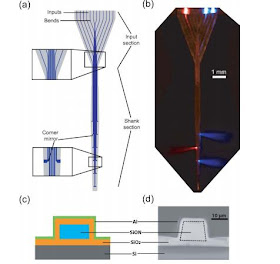I was told by some of you that you dreaded reading Nuit Blanche, because since all y'all are a competitive bunch, you were afraid to find the subject you were working on featured as part of somebody else's paper. Right then, with a simple read your three month's time investment is gone to waste. It's too bad. So instead of having a bunch of CS papers to read over the week-end, here is an open ended problem with open ended questions:
This video shows Ed Boyden explaining the technique currently investigated of the stimulation of brain cells through some sort of structured lighting. Here is the publication page of his lab. This is a fascinating subject at the cross road of technology, physics and biology together. The patient (right now they are at the animal trials) is injected with a biomarker that will produce some electric field when shone by light at some specified wavelength. However, since there are many places in the brain where one would want to have an (electrical) effect, a single fiber optic cannot really do the job. Ed and his teams have devised a way for the delivery of multiple rays of light along the fiber[1].
I wonder how fine tuned their light multiplexing system is ? So here is my first open ended question: how can you improve the technology to get more than one structured lighting in ? Right now the configuration does not seem to allow for modulation. Lines of thoughts might include Opaque Lenses.
Once you have delivered all these lights beam throughout the brain, you also want to check the response of the brain. Ed and his team used fMRI to see how the cells eventually react in the brain.[2]
Once you have delivered all these lights beam throughout the brain, you also want to check the response of the brain. Ed and his team used fMRI to see how the cells eventually react in the brain.[2]
Other open ended questions include:
Reference:
[1] Multiwaveguide implantable probe for light delivery to sets of distributed brain targets, Anthony N. Zorzos, Edward S. Boyden, and Clifton G. Fonstad
- one structured lighting yields one response, if one allows for some light multiplexing, one could consider compressed sensing as a technique to be used but is the brain response linear ?
- In the affirmative, are there good reasons to expect a sparse solution in this system of linear equations involving light inputs and MRI outputs ?
- .....
Reference:
[1] Multiwaveguide implantable probe for light delivery to sets of distributed brain targets, Anthony N. Zorzos, Edward S. Boyden, and Clifton G. Fonstad
[2] Mapping Brain Networks in Awake Mice Using Combined Optical Neural Control and fMRI , Desai M., Kahn I., Knoblich U., Bernstein J., Atallah H., Yang A., Kopell, N., Buckner R.L., Graybiel A. M., Moore C. I., & Boyden E. S.


Great stuff! thanks!
ReplyDelete